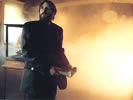Eye For Film >> Movies >> The Fog (2005) Film Review
Made at a time when there were still drive-in theatres all across America and B-grade horror was typically viewed through a thick miasma of marijuana smoke, John Carpenter's The Fog turned murky mists and foggy hazes into sources of paranoid terror, in a move cleverly designed to send the target audience into a stoner panic. Today, in the era of the no-smoking multiplex, the effect is entirely lost, but that is not all that has gone astray in Rupert Wainwright's unnecessary and unnecessarily bland remake of what few would in any case regard as one of Carpenter's best films. In the 27 years that the ghosts of the original have lain dormant, there is no question that they have grown more rotten.
As the community of Antonio Bay sees a statue of its four founding fathers unveiled outside the town hall, Nick Castle (Tom Welling) has other things on his mind. His chartered boat business is hitting rock bottom, his "token black" first mate Spooner (DeRay Davis) is like a fish out of water, his girlfriend Elizabeth (Maggie Grace) has unexpectedly resurfaced after a six-month stay in New York and he is not sure how local DJ and single mother Stevie (Selma Blair), whom he has been seeing on the side, will react to Elizabeth's return. Yet, all these problems are soon engulfed by the vast wall of fog that blows into town from the sea, bringing death and destruction in its wake. The citizens of Antonio Bay are being revisited by the ghosts of the past and are destined to pay a heavy price for their ancestors' hidden sins, blood for blood.

The ambiguous, the irrational and the unexplainable have always been right at home in ghost stories, but when, near the end of The Fog, Stevie declares, "I don't think any of us can say exactly what happened last night," her incomprehension probably has more to do with the general incoherence of Cooper Layne's screenplay than with anything genuinely uncanny. So concerned is the film with contriving at least one gratuitous jump-fright every five minutes that elements like character and story soon become lost in the fog.
The stage is cursorily set for a love triangle between Nick, Elizabeth and Stevie, only for this sub plot to be just as quickly tossed overboard. The intergenerational conflict, depicted in the opening scenes, similarly goes nowhere. And while it makes a certain kind of sense that Spooner, an Antonio Bay outsider, should alone have his life spared during one fog-bound massacre, that hardly explains why Nick, Stevie and Elizabeth should escape the night's events unpunished when they are not only born and bred natives of the island but also direct descendants of its murderous founders. Others are less fortunate, apparently for no other reason than that they happen not to be the main characters, or as young as the film's target demographic.
The special place that Elizabeth occupies in the otherwise implacable heart of the ghosts' vengeful leader (Rade Sherbedgia) makes no sense on any level, beyond its mere convenience as a device to keep the plot moving. And the ancient sepia photos that are revealed at the end, "borrowed" as they are from The Shining, serve only to remind viewers how superior Stanley Kubrick's film was in every respect.
Wainwright has certainly updated the effects of the original, using nearly 50 different fog machines, where Carpenter's budget was unable to stretch beyond two, and introducing a whole skeleton crew of leprous CGI spectres. In a genre where less is always more, the most, if not the only, truly chilling effect in The Fog is also the simplest - the explosively loud knocking sound that signals the ghosts' arrival at the threshold of present time - for hearing a revenant fuels the imagination, while seeing one merely deadens it.
Better, in the end, if they had stayed hidden in the all that smoky mist, where their power to frighten might have lasted. Or, indeed, if they had not risen again at all, but remained as a shadowy memory from Carpenter's original.
Reviewed on: 24 Feb 2006




















